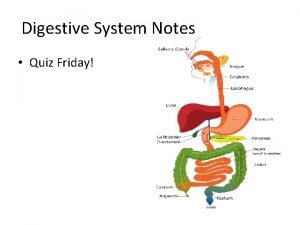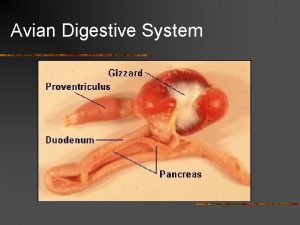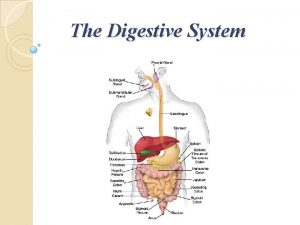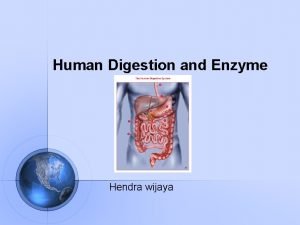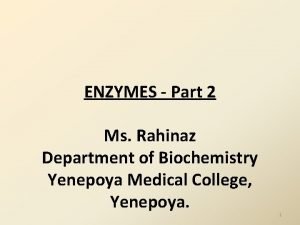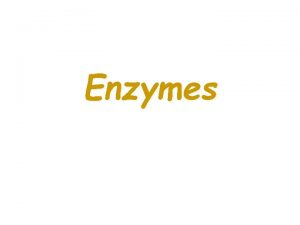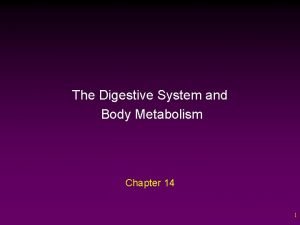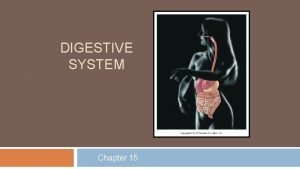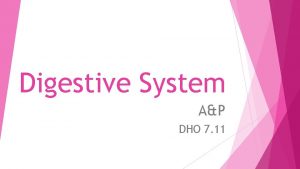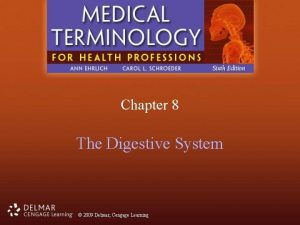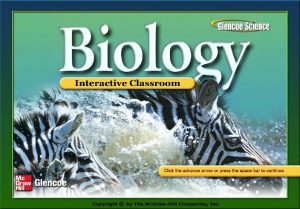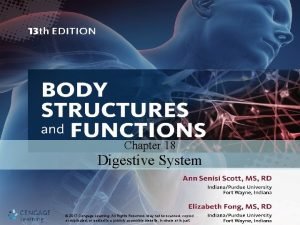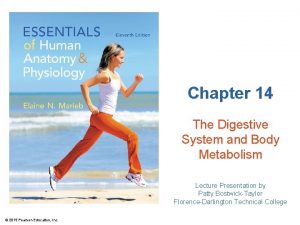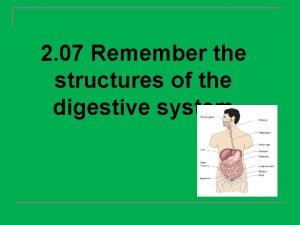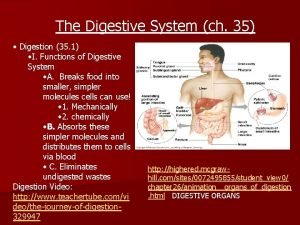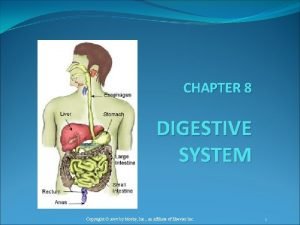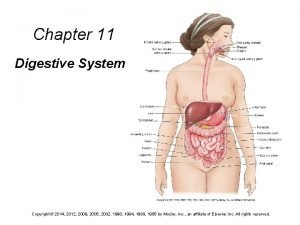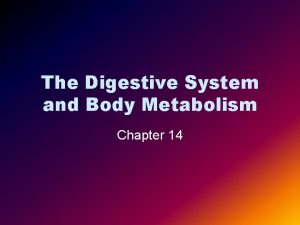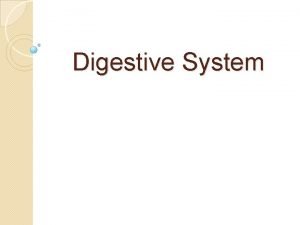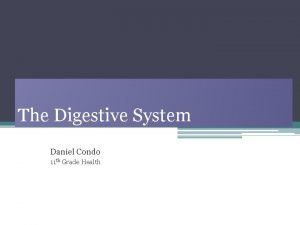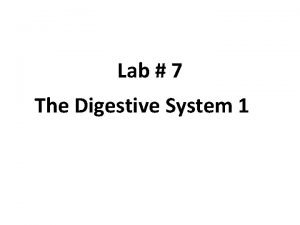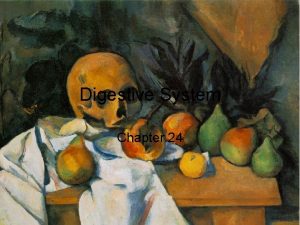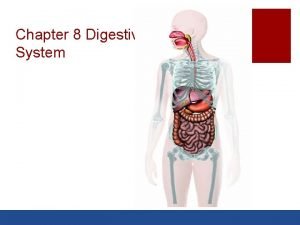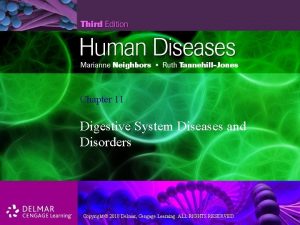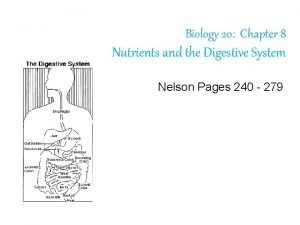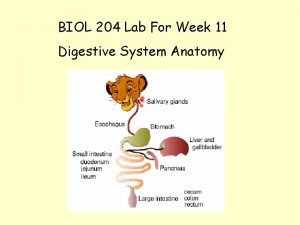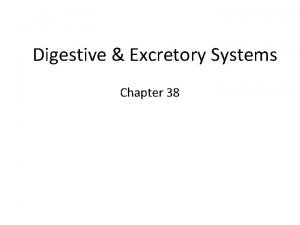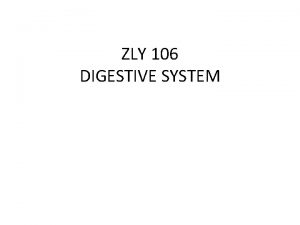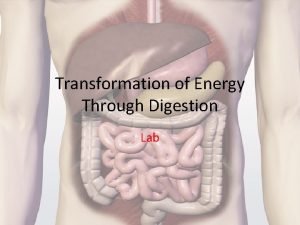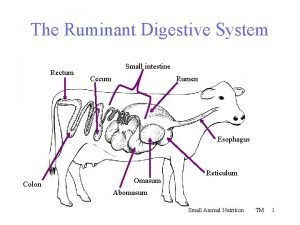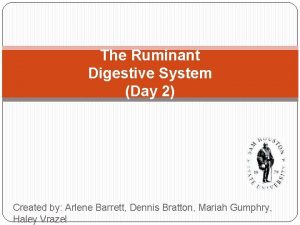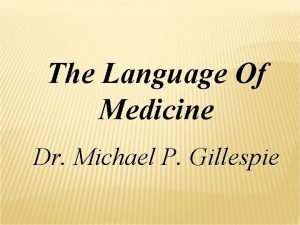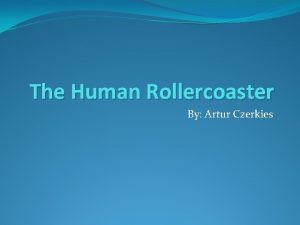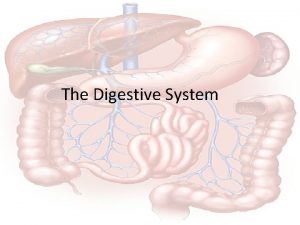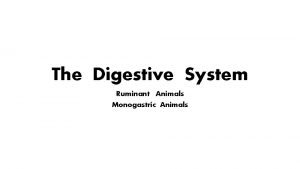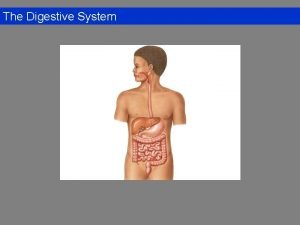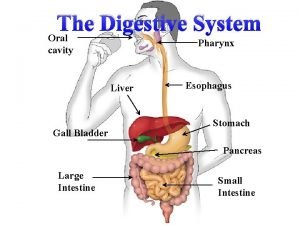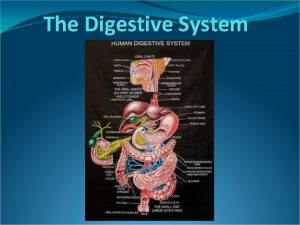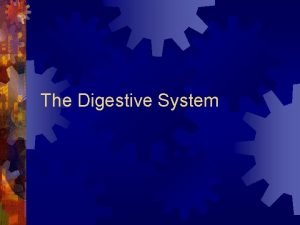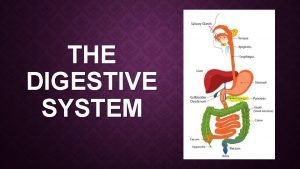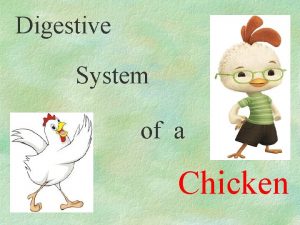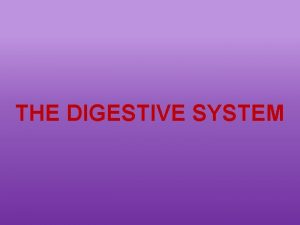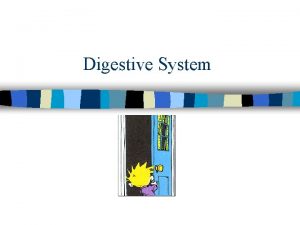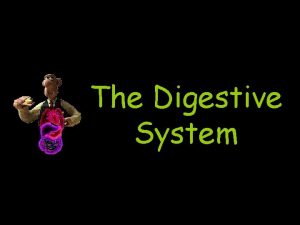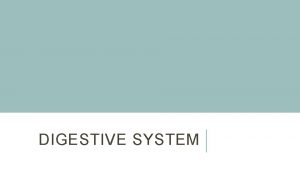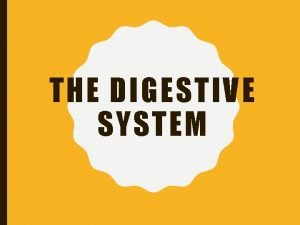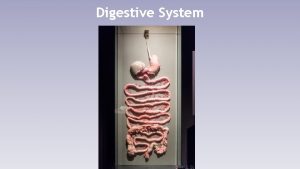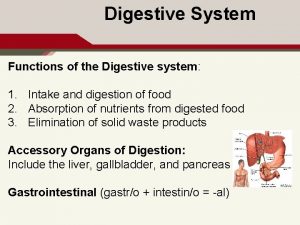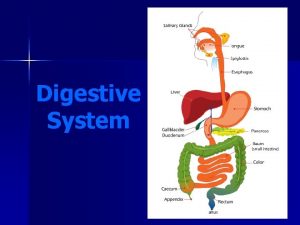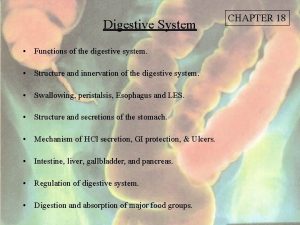DIGESTIVE SYSTEM Chapter 15 Digestive System Functions 1



















































- Slides: 51

DIGESTIVE SYSTEM Chapter 15

Digestive System Functions 1. Ingestion - mouth 2. Digestion A. Mechanical – fragment food into smaller particles (teeth, tongue, stomach, small intestine - SI) B. Chemical – enzymes, water Mouth = carbs Stomach = proteins SI = carbs, proteins, fats, nucleic acids 3. Absorption – transport from SI to blood 4. Defecation – eliminate indigestible residues (feces)

Anatomy Alimentary canal Gastrointestinal (GI) tract Mouth pharynx esophagus stomach small intestine large intestine anus Accessory digestive organs Aid in digestion, but food does not pass through Teeth, tongue, digestive glands


Alimentary Canal Mucosa (inner layer) Submucosa (next layer) Nourishes the surrounding layers of the canal and carries away absorbed materials Muscular layer Protects, secretes, absorbs Propel food through the canal Serosa (outer layer) Secretes serous fluid to keep the canal from sticking to other tissues in the abdominal cavity

Movements of the Tube 1. Mixing movements Smooth muscle rhythmically contracts Produces chyme Semi-fluid paste of food and gastric juice 2. Propelling movements Peristalsis – caused by contraction behind a mass of food (bolus) bolus as relaxation allows the mass to enter the next segment of the tube





Mouth Oral cavity: mechanical, chemical digestion Salivary glands: saliva lubricates food Saliva = mucus, salivary amylase (starch breakdown) Mastication: teeth chew food Tongue mixes food + saliva p. H of 6. 5 due to bacterial digestion of carbs Cheeks expression and chewing Lips judge temperature and texture of foods

Mouth Tongue Frenulum connects tongue to floor of mouth Papillae contain taste buds Palate Hard and soft Uvula Palatine tonsils Fight infection Pharyngeal tonsils Adenoids – located on posterior wall of pharynx

Mouth - Teeth 20 deciduous teeth; 32 secondary teeth Incisors Bite off pieces of food Cuspids – canine teeth Grasp and tear food Bicuspids and molars Grinding food Dental caries

Dental caries

Salivary Glands Secrete saliva Moisten food, binds food, begins chemical digestion, cleanses Solvent so food can be tasted Mucus (mucous cells) Binds food and lubricates Three major types: Sublingual – secrete thick and stringy saliva Parotid – secretes amylase (serous cells) Enzyme that digest carbohydrates (amylose) Submandibular – secrete viscous fluid

Pharynx Pharynx: back of throat and passageway into esophagus Connects nasal and oral cavities Divided into: Nasopharynx (top portion) Oropharynx (middle portion) Laryngopharynx Epiglottis: (bottom portion) flap of cartilage, covers trachea when swallowing Peristalsis (involuntary waves of muscle contraction)

Esophagus (gullet): passageway to stomach Collapsible About 25 cm long Esophageal sphincter Prevents regurgitation Hiatal hernia

Swallowing Mechanism Soft palate raises Hyoid and larynx are elevated Epiglottis covers the trachea Tongue presses against soft palate Pharynx pulled upward toward food Lower part of pharynx relaxes opening the esophagus Peristalsis forces food into esophagus


Stomach Stores food & breaks down food Mechanical – churn, mix Chemical – protein digestion Gastric juice: converts meal to acidic chyme HCl: p. H 2, kills bacteria, denatures proteins Pepsin: enzyme breaks down proteins Rugae = large folds Mucus = protects lining of stomach Limited absorption Moves food to small intestine

Parts of the Stomach Cardiac region Fundic region Body region Main part Pyloric region Pyloric sphincter Controls gastric emptying

Gastric Secretions Chief cells Secrete digestive enzymes Secrete pepsinogen Parietal cells Secrete HCl to convert pepsinogen into pepsin Intrinsic factor Secreted by parietal cells Needed for absorption of vitamin B 12

Regulation of Gastric Secretions Gastric juice is continuously secreted Acetylcholine Stimulates gastric glands Stimulated gastrin to be released Cholecystokinin Peptide hormone secreted by the small intestine to inhibit gastric secretions

Mixing and Emptying Actions Chyme Semi-fluid paste of food particles and gastric juice Peristalsis Move chyme from stomach (pyloric region) to small intestine (duodenum) Rate Depends on fluidity and type of food present Vomiting

Pancreas Pancreatic juice Breakdown carbs, fats, proteins, and nucleic acids Pancreatic enzymes Amylase Lipase Splits starches into disaccharides Breaks lipids into glycerol & fatty acids Trypsin and chymotrypsin Released in inactive form become active upon reaching small intestine Break down proteins Acute pancreatitis Cystic fibrosis

Acute Pancreatitis

Cystic fibrosis

Liver Controls blood glucose levels Lipid metabolism Protein metabolism Break down amino acids, form urea, clotting factors Macrophages Detoxification Bile salts: salts made in liver, stored in gallbladder Emulsify fats (make smaller droplets) Warehouse Vitamin B 12, A, and D, glycogen

Gall Bladder Stores bile Enzyme that breaks down fats Emulsification Absorption of fatty acids, vitamins A, D, E, and K Cholecystokinin Gall stones Bile cholesterol precipitates


Gall Stones Hardened deposits of digested fluid

Small Intestine Digestion & absorption Duodenum: (1 st section) digestive juices, major chemical digestion Jejunum (2 nd): absorb nutrients Ileum (3 rd): absorb Vitamin B 12, bile salts, remaining nutrients Mesentery Suspends portions from posterior abdominal wall Intestinal villi Greatly increase SA for absorption

Folds, villi and microvilli increase surface area for absorption

Secretions of the Small Intestine Peptidases (trypsin) Split Sucrase, maltase, lactase Split peptides into amino acids disaccharides into monosaccharides Lactose intolerance Do not produce sufficient lactase

Large Intestine (Colon) Absorb water, eliminate food residue Cecum: pouch where SI & LI meet, ferment plant material Appendix = extension of cecum, role in immunity Bacteria: Bacteria make Vitamin K, produce gases Rectum: feces stored until elimination Appendicitis Hemorrhoids Varicose veins of the rectum

Hemorrhoids

HOMEOSTATIC IMBALANCES OF DIGESTIVE SYSTEM AND NUTRITION

Gastric Ulcers Lesions in the stomach lining Caused mainly by bacterium Helicobacter pylori

Appendicitis Inflammation of appendix

Vomiting (emesis) Caused by irritation of stomach; inner ear disturbance Abdominal muscles & diaphragm contract “reverse peristalsis”

Diverticulosis When diet lacks bulk (low-fiber diet) Diverticula: pouches form on colon wall Diverticulitis: when diverticula become inflamed feces gets trapped, bacteria grow in pouch

Hepatitis Inflammation of liver Viral infection from contaminated water, blood transfusions, needles Jaundice

Cirrhosis Chronic inflammation of liver Severe damage hard and fibrous liver Alcoholism

Nutrition Nutrient: substance in food used to promote growth, maintenance, and repair Major nutrients: Carbohydrates – sugars & starches Lipids – saturated/unsaturated fats Proteins – eggs, milk, meat (complete – all AA); legumes, nuts, cereals (incomplete) Vitamins – A, B, C, E, D, K Minerals – Ca, P, K, S, Na, Cl, Mg

Carbohydrates Various forms Cellulose Cannot digest, but does move food through intestine Utilization Oxidized for cellular fuel Synthesis of nucleic acids

Lipids Fats and oils Utilization Phospholipid synthesis Cholesterol for cell membranes and organelle membranes Insulation Absorb fat soluble vitamins

Proteins Polymers of amino acids Essential vs. nonessential amino acids Essential – body cannot make so taken in through food Nonessential – created within your body, so not an essential part of your diet (still have essential roles though) Enzymes Control metabolic functions

Vitamins Organic compounds required in small amounts for metabolism (coenzymes) Fat soluble A, D, E, K Water soluble B and C vitamins

Minerals Elements other than carbon that are essential in metabolism (cofactors) Major minerals Ca and P – 75% of weight of minerals K, S, Na, Cl, Mg Trace elements Essential nutrients needed only in small amounts Fe – part of the RBC heme group Anemia- Lack Fe leads to fatigue, muscle cramps, lack of energy

Nutrition Malnutrition – poor nutrition that results either from a lack of essential nutrients or a failure to utilize them May result from under-nutrition or overnutrition Daily caloric intake based on: Age Sex Height Exercise level 2700 for males and 1800 -2000 for females

Nutrition http: //cleanvideosearch. com/media/action/yt/watch? video. Id=v. WNRK ju 0 K-g Mediterranean Diet http: //cleanvideosearch. com/media/action/yt/watch? video. Id=St. BVFyt Bz. PI Magic School Bus for Lunch http: //cleanvideosearch. com/media/action/yt/watch? video. Id=e. Db 1 V V 9 VZyo
 Pathway of the food
Pathway of the food Pathway of food through digestive tract
Pathway of food through digestive tract Bird digestive system functions
Bird digestive system functions Define todays
Define todays Symptoms of h pylori
Symptoms of h pylori Respiratory digestive and circulatory system
Respiratory digestive and circulatory system Enzyme secreted by small intestine
Enzyme secreted by small intestine Digestive enzymes and their functions table
Digestive enzymes and their functions table Digestive enzymes and their functions table
Digestive enzymes and their functions table Figure 14-1 is a frontal view of the digestive system
Figure 14-1 is a frontal view of the digestive system Chapter 15 digestive system
Chapter 15 digestive system 7:11 digestive system diagram
7:11 digestive system diagram Chapter 8 the digestive system labeling exercises
Chapter 8 the digestive system labeling exercises Chapter 35 section 1 the digestive system
Chapter 35 section 1 the digestive system Chapter 18 digestive system
Chapter 18 digestive system The digestive system and body metabolism chapter 14
The digestive system and body metabolism chapter 14 Chapter 7:11 digestive system labeling
Chapter 7:11 digestive system labeling Chapter 35 section 1 the digestive system answer key
Chapter 35 section 1 the digestive system answer key Chapter 8 the digestive system
Chapter 8 the digestive system Anatomy and physiology coloring workbook figure 14-1
Anatomy and physiology coloring workbook figure 14-1 Chapter 7:11 digestive system
Chapter 7:11 digestive system Chapter 14 the digestive system and body metabolism
Chapter 14 the digestive system and body metabolism Chapter 7:11 digestive system
Chapter 7:11 digestive system Chapter 7:11 digestive system
Chapter 7:11 digestive system What is the function of anus
What is the function of anus Chapter 7:11 digestive system
Chapter 7:11 digestive system Chapter 7:11 digestive system
Chapter 7:11 digestive system Pyloric valve
Pyloric valve Chapter 8 digestive system
Chapter 8 digestive system Chapter 7 11 digestive system
Chapter 7 11 digestive system Chapter 8 the digestive system
Chapter 8 the digestive system 7:11 digestive system
7:11 digestive system Nervous system and digestive system
Nervous system and digestive system Piecewise function absolute value
Piecewise function absolute value Evaluating functions and operations on functions
Evaluating functions and operations on functions Evaluating functions and operations on functions
Evaluating functions and operations on functions Chapter 38 digestive and excretory systems answer key
Chapter 38 digestive and excretory systems answer key Chapter 46 digestive and endocrine disorders
Chapter 46 digestive and endocrine disorders Sheep ruminant digestive system
Sheep ruminant digestive system What is this
What is this Energy transformation in digestion
Energy transformation in digestion Sheep digestive system
Sheep digestive system Ruminants fourth stomach
Ruminants fourth stomach Which term means “no sperm or semen are produced”?
Which term means “no sperm or semen are produced”? Digestive system roller coaster project
Digestive system roller coaster project What produces bile
What produces bile Four chambers of ruminants
Four chambers of ruminants Adventitia vs serosa
Adventitia vs serosa Digestive system model
Digestive system model Introduction of digestive system
Introduction of digestive system Intestinal glands
Intestinal glands Digestive system function
Digestive system function
